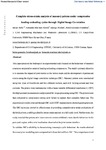Complete stress-strain analysis of masonry prisms under compressive loading-unloading cycles through digital image correlation

No accesible hasta 2026-01-01
Use este enlace para citar
http://hdl.handle.net/2183/38011
Excepto si se señala otra cosa, la licencia del ítem se describe como Atribución-NoComercial-SinDerivadas 3.0 España
Colecciones
- Investigación (ETSECCP) [826]
Metadatos
Mostrar el registro completo del ítemTítulo
Complete stress-strain analysis of masonry prisms under compressive loading-unloading cycles through digital image correlationFecha
2024Cita bibliográfica
Bello, I., Martínez-Abella, F., Wardeh, G., & González-Fonteboa, B. (2024). Complete stress-strain analysis of masonry prisms under compressive loading-unloading cycles through digital image correlation. Engineering Structures, 298, 117088. https://doi.org/10.1016/j.engstruct.2023.117088
Resumen
[Abstract:] This paper presents the findings of an experimental study focused on the behaviour of masonry structures subjected to uniaxial loading-unloading compression. The study's primary objective is to examine the impact of joint mortar on the failure mode and the development of permanent strains using the digital image correlation technique (DIC). Masonry prisms were constructed using two types of fired bricks and five different mortars, each with varying cement and lime contents. The prisms were instrumented with a linear variable differential transformer (LVDT) for displacement measurements and prepared for image processing using DIC. The prisms were then subjected to compression testing until failure to capture their complete behaviour. The experimental results obtained through DIC and LVDT measurements showed good agreement. The DIC technique proved its effectiveness in providing comprehensive strain evaluations of the brick prisms, enabling a detailed stress-strain analysis at a full-scale level. Furthermore, the study revealed that prisms with lower cement content exhibited a more ductile behaviour in the post-peak region, with strain localisation observed at the joint mortar interface.
To validate DIC's reliability in characterising masonry's cyclic behaviour, the results obtained from analytical modelling were compared with those derived from DIC. This comparison aimed to confirm the accuracy and consistency of DIC measurements. Overall, this study contributes to our understanding of masonry behaviour under compression and highlights the capabilities of DIC in capturing strain patterns and providing valuable insights into the influence of joint mortar on the structural response of masonry elements.
Palabras clave
Masonry
Joint mortar
Stress-strain relationship
Digital image correlation (DIC)
Analytical modelling
Joint mortar
Stress-strain relationship
Digital image correlation (DIC)
Analytical modelling
Versión del editor
Derechos
Atribución-NoComercial-SinDerivadas 3.0 España






